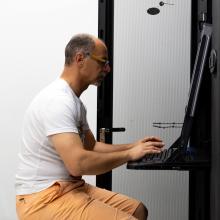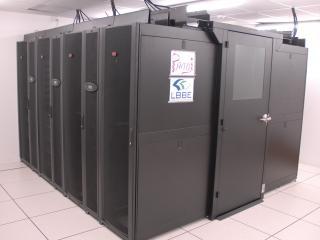Computing services
Members
Ingénieur d'études
CNRS
Tel: 04 72 44 81 42

Ingénieur d'études
CNRS
Tel: 33 04 72 43 11 68

Ingénieur d'études
CNRS
Tel: 04 72 43 35 82

Technicien
UCBL
Tel: 33 04 72 43 29 04

Ingénieur d'études
CNRS
Tel: 33 04 72 43 29 04

Ingénieure de recherche
UCBL
Tel: 33 04 72 44 85 98

Ingénieur de recherche
CNRS
Tel: 33 06 82 87 93 59

Ingénieur de recherche
CNRS
Tel: 33 04 26 23 44 70
info@listes-lbbe.univ-lyon1.fr
The "Pôle informatique" (hereafter called "PI") is constituted of 8 engineers (1T, 4IE, 3IR). Our activities are distributed among three main directions: computing and storage infrastructure management (shared resources, and invidual equipment), software and service development and data analysis in molecular biology and ecology.
Infrastructures managment
- Microcomputing: the PI is in charge of managing the laboratory's microcomputer equipment, from choosing the most appropriate solution in consultation with the future user to managing maintenance, including installation and configuration of the equipment.
- Laboratory Information System: the PI provides laboratory and community members with a number of services, including several web servers (apache), numerous database servers (relational or indexed) and several collaborative tools (Git, Redmine, Seafile...). These services are hosted on largely virtualized machines.

- Compute and storage: since 2009, the PI manages a computing cluster with almost 1200 avalaible computing cores. The cluster is linked to a 600 TB high performing distributed storage system under BeeGFS and an object mode storage based on iRods (~400 useful TB).
- Cloud and containerization: cloud-girofle (224 vcpu and 120 To), the local cloud operated by the PI since 2017, is part of the Biosphere cloud federation from the French Institute of Bioinformatics (IFB). We are starting to converge our virtualization infrastructure towards containerization technologies (docker, singularity).
- User support: the PI provides user support for all the resources and tools available to the laboratory's members. It trains and supports users in their use of shared resources through trainingsessions, information and monitoring meetings and mailing lists.
Software and methodological development
Members of the PI are involved in numerous software development projects in collaboration with the lab researchers, covering a large range of programming languages (R, Python, C++, OCaml, Javascript, SQL, shell). It goes from optimized parallel numerical codes to web services and dedicated databases (SQL or no-SQL). A peculiar effort is also performed to share the best practices of modern software development and make these software codes reproducible and available following the standards and requirements of the community.
Data analysis
Members of the PI are in the front line facing the data avalanche (and the data diversity) of this decade.
A large part of our activity is related to the quantity of data coming from sequencing technologies. The PI develops and proposes pipelines for genomic data assembly and annotation, RNA-seq and RAD-seq data analysis. More recently, computer image processing has become an important issue for future ecological studies performed in the lab in the Evolutionary Ecology.
Animation, training and scientific expertise
Our group has set up a series of dedicated workshops to improve internal skills in software engineering, distributed computing, programming and data analysis, which complements more formal teaching sessions. Members of the group are also involved in training activities in universities (UCBL1) and CNRS (Formation permanente).
In their respective fields, members of the PI actively monitor technological developments and participate in major events such as JOBIM (bioinfo), the JRES (system administration), the JDEV (development), the Aramis days (system and network administration and software development) and the 'Rencontres R' (programmation). The PI is also involved in dedicated networks and/or projects of national scope such as the LyonCalcul group, the RLyon group and the IFB-NNCR and IFB-Core projects.
We works in close cooperation with the bioinformatics platform PRABI (Pôle Rhône-Alpes de BioInformatique), notably for the management of the computing and storage infrastructure, the diffusion of our lab's software production, the organization of teaching sessions and for sharing expertise in genomic/transcriptomic data analysis.
Poster
Publications
Display of 31 to 60 publications on 170 in total
Larval density in the invasive Drosophila suzukii : Immediate and delayed effects on life‐history traits
Ecology and Evolution . 13 ( 8 ) : e10433
DOI: 10.1002/ece3.10433
Journal article
see the publicationPhylteR: Efficient Identification of Outlier Sequences in Phylogenomic Datasets
Molecular Biology and Evolution . 40 ( 11 ) : msad234
Journal article
see the publicationNeural Networks beyond explainability: Selective inference for sequence motifs
Transactions on Machine Learning Research Journal .
Journal article
see the publicationTranscriptome-wide deregulation of gene expression by artificial light at night in tadpoles of common toads
Science of the Total Environment . 818 : 151734
Journal article
see the publicationExtraire des informations fiables des décisions de justice dans une perspective prédictive : des obstacles techniques et des obstacles théoriques
Jurimétrie - Revue de la mesure des phénomènes juridiques . ( 2 )
Journal article
see the publicationrbioacc: An R-package to analyze toxicokinetic data
Ecotoxicology and Environmental Safety . 242 : 113875
Journal article
see the publicationAdaptive duplication and genetic diversification of protein kinase R contribute to the specificity of bat-virus interactions
Science Advances . 8 ( 47 )
Journal article
see the publicationMeta-transcriptomics reveals stress adaptation processes in microbial communities differing in exposure history
"Ecology and Evolution: New perspectives and societal challenges" SFE2-GfÖ-EEF joint meeting, International conference on ecological sciences .
Conference paper
see the publicationtidy tree : A New Layout for Phylogenetic Trees
Molecular Biology and Evolution . 39 ( 10 ) : msac204
Journal article
see the publicationBayesian investigation of SARS-CoV-2-related mortality in France
Peer Community Journal . 2 ( e6 )
Journal article
see the publicationThirdkind: displaying phylogenetic encounters beyond 2-level reconciliation
Bioinformatics . 38 ( 8 ) : 2350–2352
Journal article
see the publicationTaking full advantage of modelling to better assess environmental risk due to xenobiotics
Environmental Science and Pollution Research .
Journal article
see the publicationResearch response to coronavirus disease 2019 needed better coordination and collaboration: a living mapping of registered trials
Journal of Clinical Epidemiology . ( 130 ) : 107-116
Journal article
see the publicationDILS: Demographic inferences with linked selection by using ABC
Molecular Ecology Resources .
Journal article
see the publicationLifespan decreases with proportion of sons in males but not females of zoo‐housed tigers and lemurs
Journal of Evolutionary Biology .
DOI: 10.1111/jeb.13793
Journal article
see the publicationSex‐specific actuarial and reproductive senescence in zoo‐housed tiger ( Panthera tigris ): The importance of sub‐species for conservation
Zoo Biology .
DOI: 10.1002/zoo.21610
Journal article
see the publicationAnticoagulation prior to hospitalization is a potential protective factor for COVID-19: insight from a French multicenter cohort study
Journal of the American Heart Association . 10 ( 8 ) : e018288
Journal article
see the publicationWho benefits most from Lyon’s bike sharing system?
PLoS ONE . 15 ( 4 )
Journal article
see the publicationTreerecs: an integrated phylogenetic tool, from sequences to reconciliations.
Bioinformatics . 36 ( 18 ) : 4822-4824
Journal article
see the publicationEvolutionary stasis of the pseudoautosomal boundary in strepsirrhine primates
eLife . 9
DOI: 10.7554/eLife.63650
Journal article
see the publicationEvolutionary plasticity of mating-type determination mechanisms in Paramecium aurelia sibling species
Genome Biology and Evolution . ( evaa258 )
DOI: 10.1093/gbe/evaa258
Journal article
see the publicationRevisiting giraffe photo-identification using deep learning and network analysis
Preprint
see the publicationStudying genetic antagonisms as drivers of genome evolution
Peer Community In Evolutionary Biology .
Journal article
see the publicationUtilisation de DRomics pour modéliser les données omiques de type dose-réponse dans le cadre de l’appréciation du risque environnemental
SEFA (Société d’Ecotoxicologie Fondamentale et Appliquée) .
Conference paper
see the publicationDRomics: an R tool for modelling omics dose-response data
Congrès useR! .
Poster
see the publicationIFB-Biosphère, Services Cloud pour l'Analyse des Données des Sciences de la Vie
JRES (Journées réseaux de l'enseignement et de la recherche ) 2019 .
Conference paper
see the publicationPollen limitation as a main driver of fruiting dynamics in oak populations
Ecology Letters . 22 ( 1 ) : 98-107
DOI: 10.1111/ele.13171
Journal article
see the publicationCAARS: comparative assembly and annotation of RNA-Seq data
Bioinformatics . 35 ( 13 ) : 2199-2207
Journal article
see the publication